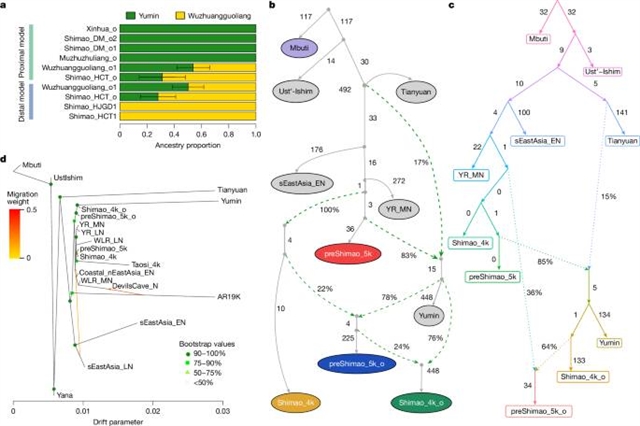
中国科学院古脊椎动物与古人类研究所付巧妹研究小组揭示了石茂市的古代DNA记录了新石器时代中国的亲属关系。2025年11月26日出版的《自然》杂志发表了这项成果。
在这里,研究组通过对石茂市及其卫星城市的144个古代基因组进行测序,展示了墓主的谱系,跨度可达五代。这些发现揭示了世茂社区中主要的父系血统结构,以及可能的性别特定的祭祀仪式。课题组人员还描述了人口历史,揭示了世茂文化相关人口主要起源于至少1000人的仰韶文化相关人口。从内蒙古持续流入的与玉民有关的种群并没有中断区域遗传的连续性。南方大陆祖先对世茂文化相关人群的遗传影响更大,这支持了水稻种植向北扩展的证据,比之前预期的要多。总之,这些结果揭示了早期国家建立的区域人口和社会结构的精细细节。
据了解,世茂城的发现(约2300-1800 BCE)是中国陕西第一个国家级新石器时代的设防聚落,在帮助他们理解社会分层城市社会的出现方面发挥了重要作用。然而,关于祖先和亲属关系是如何塑造这个以人类祭祀为特征的阶级社会的等级制度的关键问题仍然存在。世茂和其他黄土高原聚落的始祖人群的起源,以及他们在更广泛的祖先景观中的相互作用,还有待确定。
附:英文原文
Title: Ancient DNA from Shimao city records kinship practices in Neolithic China
Author: Chen, Zehui, Gardner, Jacob D., Sun, Zhouyong, Bennett, E. Andrew, Han, Qian, Pei, Xuesong, Shao, Jing, Shi, Han, Wang, Wenjun, Xue, Jiayang, Bai, Fan, Dai, Xiangming, He, Nu, Guo, Xiaoning, Di, Nan, Mao, Xiaowei, Liu, Tianxiang, Cao, Peng, Liu, Feng, Dai, Qingyan, Feng, Xiaotian, Ping, Wanjing, Wu, Xiaohong, Zhang, Lizhao, Chen, Liang, Fu, Qiaomei
Issue&Volume: 2025-11-26
Abstract: The discovery of Shimao city (around 2300–1800BCE1), a premier state-level Neolithic fortified settlement in Shaanxi, China2, played an important role in helping us understand the emergence of socially stratified urban societies. However, key questions remain regarding how ancestry and kinship shaped the hierarchy of this class-based society characterized by human sacrifice. The origin of the founding populations of Shimao and other Loess Plateau settlements, and their interactions within the broader ancestral landscape, have yet to be determined. Here we present, by sequencing 144 ancient genomes from Shimao city and its satellites, pedigrees among tomb owners spanning up to four generations. These findings reveal a predominantly patrilineal descent structure across Shimao communities, and possibly sex-specific sacrificial rituals. We also characterize the population history, revealing that Shimao culture-related populations originated mostly from a Yangshao culture-related population present at least 1,000years earlier, and the lasting inflow of Yumin-related populations from Inner Mongolia did not interrupt regional genetic continuity. Broader genetic influence from southern mainland ancestry over Shimao culture-related populations supports evidence of rice farming expanding further north than previously expected. Together, these results uncover fine details of the regional peopling and social structure of early state establishment.
DOI: 10.1038/s41586-025-09799-x
Source: https://www.nature.com/articles/s41586-025-09799-x
Nature:《自然》,创刊于1869年。隶属于施普林格·自然出版集团,最新IF:69.504
官方网址:http://www.nature.com/
投稿链接:http://www.nature.com/authors/submit_manuscript.html
